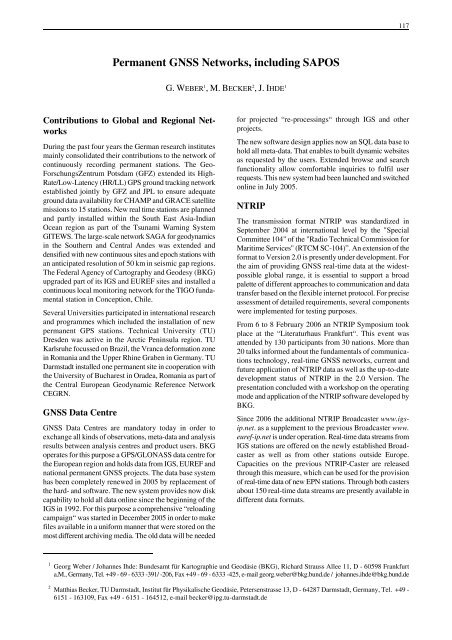NATIONAL REPORT OF THE FEDERAL REPUBLIC OF ... - IAG Office
NATIONAL REPORT OF THE FEDERAL REPUBLIC OF ... - IAG Office
NATIONAL REPORT OF THE FEDERAL REPUBLIC OF ... - IAG Office
You also want an ePaper? Increase the reach of your titles
YUMPU automatically turns print PDFs into web optimized ePapers that Google loves.
Permanent GNSS Networks, including SAPOS<br />
Contributions to Global and Regional Networks<br />
During the past four years the German research institutes<br />
mainly consolidated their contributions to the network of<br />
continuously recording permanent stations. The Geo-<br />
ForschungsZentrum Potsdam (GFZ) extended its High-<br />
Rate/Low-Latency (HR/LL) GPS ground tracking network<br />
established jointly by GFZ and JPL to ensure adequate<br />
ground data availability for CHAMP and GRACE satellite<br />
missions to 15 stations. New real time stations are planned<br />
and partly installed within the South East Asia-Indian<br />
Ocean region as part of the Tsunami Warning System<br />
GITEWS. The large-scale network SAGA for geodynamics<br />
in the Southern and Central Andes was extended and<br />
densified with new continuous sites and epoch stations with<br />
an anticipated resolution of 50 km in seismic gap regions.<br />
The Federal Agency of Cartography and Geodesy (BKG)<br />
upgraded part of its IGS and EUREF sites and installed a<br />
continuous local monitoring network for the TIGO fundamental<br />
station in Conception, Chile.<br />
Several Universities participated in international research<br />
and programmes which included the installation of new<br />
permanent GPS stations. Technical University (TU)<br />
Dresden was active in the Arctic Peninsula region. TU<br />
Karlsruhe focussed on Brazil, the Vranca deformation zone<br />
in Romania and the Upper Rhine Graben in Germany. TU<br />
Darmstadt installed one permanent site in cooperation with<br />
the University of Bucharest in Oradea, Romania as part of<br />
the Central European Geodynamic Reference Network<br />
CEGRN.<br />
GNSS Data Centre<br />
GNSS Data Centres are mandatory today in order to<br />
exchange all kinds of observations, meta-data and analysis<br />
results between analysis centres and product users. BKG<br />
operates for this purpose a GPS/GLONASS data centre for<br />
the European region and holds data from IGS, EUREF and<br />
national permanent GNSS projects. The data base system<br />
has been completely renewed in 2005 by replacement of<br />
the hard- and software. The new system provides now disk<br />
capability to hold all data online since the beginning of the<br />
IGS in 1992. For this purpose a comprehensive “reloading<br />
campaign“ was started in December 2005 in order to make<br />
files available in a uniform manner that were stored on the<br />
most different archiving media. The old data will be needed<br />
G. WEBER 1 , M. BECKER 2 , J. IHDE 1<br />
1 Georg Weber / Johannes Ihde: Bundesamt für Kartographie und Geodäsie (BKG), Richard Strauss Allee 11, D - 60598 Frankfurt<br />
a.M., Germany, Tel. +49 - 69 - 6333 -391/ -206, Fax +49 - 69 - 6333 -425, e-mail georg.weber@bkg.bund.de / johannes.ihde@bkg.bund.de<br />
2 Matthias Becker, TU Darmstadt, Institut für Physikalische Geodäsie, Petersenstrasse 13, D - 64287 Darmstadt, Germany, Tel. +49 -<br />
6151 - 163109, Fax +49 - 6151 - 164512, e-mail becker@ipg.tu-darmstadt.de<br />
117<br />
for projected “re-processings“ through IGS and other<br />
projects.<br />
The new software design applies now an SQL data base to<br />
hold all meta-data. That enables to built dynamic websites<br />
as requested by the users. Extended browse and search<br />
functionality allow comfortable inquiries to fulfil user<br />
requests. This new system had been launched and switched<br />
online in July 2005.<br />
NTRIP<br />
The transmission format NTRIP was standardized in<br />
September 2004 at international level by the "Special<br />
Committee 104" of the "Radio Technical Commission for<br />
Maritime Services" (RTCM SC-104)”. An extension of the<br />
format to Version 2.0 is presently under development. For<br />
the aim of providing GNSS real-time data at the widestpossible<br />
global range, it is essential to support a broad<br />
palette of different approaches to communication and data<br />
transfer based on the flexible internet protocol. For precise<br />
assessment of detailed requirements, several components<br />
were implemented for testing purposes.<br />
From 6 to 8 February 2006 an NTRIP Symposium took<br />
place at the “Literaturhaus Frankfurt“. This event was<br />
attended by 130 participants from 30 nations. More than<br />
20 talks informed about the fundamentals of communications<br />
technology, real-time GNSS networks, current and<br />
future application of NTRIP data as well as the up-to-date<br />
development status of NTRIP in the 2.0 Version. The<br />
presentation concluded with a workshop on the operating<br />
mode and application of the NTRIP software developed by<br />
BKG.<br />
Since 2006 the additional NTRIP Broadcaster www.igsip.net.<br />
as a supplement to the previous Broadcaster www.<br />
euref-ip.net is under operation. Real-time data streams from<br />
IGS stations are offered on the newly established Broadcaster<br />
as well as from other stations outside Europe.<br />
Capacities on the previous NTRIP-Caster are released<br />
through this measure, which can be used for the provision<br />
of real-time data of new EPN stations. Through both casters<br />
about 150 real-time data streams are presently available in<br />
different data formats.











